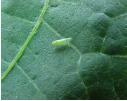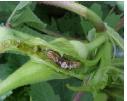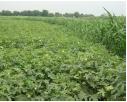IPM Strategies for Okra
IPM Strategies for Okra
Among various vegetables, okra, commonly known as Lady’s finger is the most common and extensively grown all over the country. One of the major constraints identified in its production is the increasing incidence of insect pests, diseases and nematodes, sometimes resulting in substantial yield losses. Due to its tender and supple nature and its cultivation under high moisture & input regimes, okra is more prone to pest attack and at a conservative estimate cause about 35-40% losses.
Problems related to high use of pesticides
To mitigate the losses due to pests, a huge quantity of pesticides is used in okra
- The vegetables which are harvested at short intervals are likely to retain unavoidably high level of pesticide residues which may be highly hazardous to consumers.
- The excessive reliance on chemicals has led to the problem of resistance, resurgence, environmental pollution and decimation of useful fauna & flora.
Okra - key pests
Leaf hopper
Nymphs and adults of leaf hopper are pale green and move diagonally. The affected leaves turn yellowish and curl. In case of heavy infestation the leaves turn brick red and crumble.
The affected leaves turn yellowish and curl. In case of heavy infestation the leaves turn brick red and crumble.
Shoot and fruit borer
 When the crop is young, larvae bore into tender shoots and tunnel downwards which wither, drop down and growing points are killed. In fruits, the larvae bore inside these and feed on inner tissues which become deformed in shape with no market value.
When the crop is young, larvae bore into tender shoots and tunnel downwards which wither, drop down and growing points are killed. In fruits, the larvae bore inside these and feed on inner tissues which become deformed in shape with no market value.
Red spider mite
 Larvae & nymphs are greenish red while adults a re oval, reddish brown in colour. Mites feed on the under surface of leaves and the affected leaves g radually start curling and get wrinkled and crumpled.
Larvae & nymphs are greenish red while adults a re oval, reddish brown in colour. Mites feed on the under surface of leaves and the affected leaves g radually start curling and get wrinkled and crumpled.
Yellow vein mosaic disease
 Interwoven network of yellow veins encompassing with islands of green tissues on leaves. Later, entire leaves turn yellow. This disease, spread by white fly, is economically most important disease.
Interwoven network of yellow veins encompassing with islands of green tissues on leaves. Later, entire leaves turn yellow. This disease, spread by white fly, is economically most important disease.
Root knot nematode
 Microscopic, soil borne, vermiform pests. They feed vigorous on roots and cause galling of roots. Affected plants are weak, stunted with yellow leaves.
Microscopic, soil borne, vermiform pests. They feed vigorous on roots and cause galling of roots. Affected plants are weak, stunted with yellow leaves.
Integrated Pest Management Strategies
- Sowing of YVMV resistant hybrids viz. Makhmali, Tulsi, Anupama-1 and Sun-40 etc. especially during kharif season of the crop.
- Grow maize/sorghum on borders as a barrier/trap crop for the entry of shoot & fruit borer adults.
- Set up yellow sticky and delta traps for white fly etc.
- Erection of bird perches @ 10/acre in the field for facilitating bird predation.
- Give two to three sprays of NSKE @ 5% alternating with sprays of pesticides, if needed, for leaf hopper, white fly, mites and aphids etc. Leaf hopper, if crosses ETL (5 hoppers/plant), spray imidacloprid 17.8 SL @ 150 ml/ha.
 This will be effective in controlling other sucking pests as well.
This will be effective in controlling other sucking pests as well. - Install pheromone traps @ 2/ acre for monitoring of Earias vittella mo th emergence. Replace the lures after every 15- 20 day interval.
- Release egg parasitoid Trichogramma chilonis @ 1-1.5 lakh/ ha starting from 30-35 days after sowing, 4-5 times at weekly interval for shoot & fruit borer. Shoot & fruit borer, if crosses ETL (5.3 % infestation), spray cypermethrin 25 EC @ 200 g a.i/ha.
- Rogue out the YVMV affected plants, if any, from time to time.
- Periodically remove and destroy the borer affected shoots and fruits.
- Need based application of chemical pesticides viz. imidacloprid 17.8 SL @ 150 ml/ha, cypermethrin 25 EC @ 200 g a.i/ha (0.005%), quinalphos 25 EC @ 0.05% or Propargite etc. 57 EC @ 0.1 % for control of leaf hoppers, aphids, white flies, borers and mites.

Natural enemies (Beneficial insects)

Do’s and Don’ts
|
Do’s |
Don’ts |
|
|
Source : Extension leaflet of National Centre for Integrated Pest Management (ICAR)
Last Modified : 3/1/2020
Various pests, natural enemies and IPM practices f...
This topic covers the Information related to Crop ...
